Extron electronics 60-1043-12 User manual
- Category
- Receiver
- Type
- User manual
This manual is also suitable for

1
Product Category
XTP T HDMI and XTP R HDMI • Setup Guide
This guide provides instructions for an experienced installer to install and connect the Extron XTP T HDMI transmitter and XTP R HDMI receiver.
Transmitter Connections Receiver Connections
a DC power connector
b HDMI input connector
c HDMI Loop-thru connector
d Analog audio input connector
e RS-232/IR Over XTP
connector
f XTP output connector
g LAN connector
h DC power connector
i XTP input connector
j LAN connector
k RS-232/IR Over XTP connector
l HDMI output connector
m Analog audio output connector
n S/PDIF audio output connector
o Relay connectors
Installation
Step 1 — Mounting
Turn off or disconnect all equipment power sources and mount the transmitter and receiver as required.
Step 2 — Connecting inputs
a. Connect a digital video source to the female HDMI connector of the XTP T HDMI (see b above). It can accept HDMI, DVI (with an
appropriate adapter), or DisplayPort video signals.
NOTES:
• Use an Extron LockIt
®
Locking Bracket to secure HDMI cables to the connectors.
• Video input from a DisplayPort source must be a dual mode DisplayPort source.
b. Connect a digital video display to the HDMI loop-thru connector on the transmitter to locally display the input source. Displays that are not
HDCP compliant display a green screen when HDCP encrypted content is sent to them (see c above).
c. Connect balanced or unbalanced stereo audio to the
3.5 mm, 5-pole captive screw connector (see d above).
Step 3 — Connecting Throughput Devices
a. Connect a twisted pair cable between the XTP connectors on
the transmitter and receiver (see f and i above).
ATTENTION: Do not connect these connectors to a computer data or telecommunications
network.
The XTP T HDMI and XTP R HDMI are compatible with CAT 5e, 6, 6a, and 7 shielded twisted pair
(F/UTP, SF/UTP, and S/FTP) and unshielded twisted pair (U/UTP) cable. Extron recommends using
the following practices to achieve full transmission distances up to 330 feet (100 m) and reduce
transmission errors.
z Use Extron XTP DTP 24 SF/UTP cable for the best performance. If not using XTP DTP 24
cable, at a minimum, Extron recommends 23 AWG, solid conductor, STP cable with a minimum
bandwidth of 400 MHz.
z Terminate cables with shielded connectors to the TIA/EIA T 568 B standard.
z Limit the use of more than two pass-through points, which may include patch points, punch
down connectors, couplers, and power injectors. If these pass-through points are required, use
CAT 6 or 6a shielded couplers and punch down connectors.
NOTE: When using CAT 5e or CAT 6 cable in bundles or conduits, consider the following:
• Do not exceed 40% ll capacity in conduits.
• Do not comb the cable for the rst 20 m, where cables are straightened, aligned, and secured in tight bundles.
• Loosely place cables and limit the use of tie wraps or hook and loop fasteners.
• Separate twisted pair cables from AC power cables.
Signal LED — Lights on the transmitter when it is transmitting a video signal or a test pattern. Lights on the receiver when it receives an
active XTP input signal from the transmitter.
Link LED — Lights yellow when a valid link between an XTP input and output is established.
TIA/EIA T 568 B
Pin Wire Color
1 White-orange
2 Orange
3 White-green
4 Blue
5 White-blue
6 Green
7 White-brown
8 Brown
12345678
RJ-45
Connector
Insert Twisted
Pair Wires
Pins:
Pin
1
2
3
4
5
6
7
8
Wire color
White-green
Green
White-orange
Blue
White-blue
Orange
White-brown
Brown
Wire color
T568A T568B
White-orange
Orange
White-green
Blue
White-blue
Green
White-brown
Brown
Do not tin the wires!
Unbalanced Stereo InputBalanced Stereo Input
Tip
Ring
Tip
Ring
Sleeves
Tip
Sleeve
Sleeve
Tip
LR
LR
POWER
12V
HDMI
1.0 A MAX
Rx GTx
RS-232 IR
RxTx
−+−+
LR
LOOP-THRU
RESET
AUDIO
OFF
ON
AUDIO
LAN
SIG LINK
XTP OUT
INPUTS
OVER XTP
POWER
12V
1.0 A MAX
Rx GTx
RS-232 IR
RL
RxTx
-+-+
1
2
AUDIO
ON
AUDIO
RESET
OVER XTP
OUTPUTS RELAYS
SIG LINK
XTP IN
LAN
HDMI
OFF
S/PDIF
XTP R HDMI Rear Panel
XTP T HDMI Rear Panel
g
a
b
k
m
n
h
ij
f
d
c
o
e
l

2
XTP T HDMI and XTP R HDMI • Setup Guide (Continued)
68-1723-50
Rev. A
07 13
© 2013 Extron Electronics — All rights reserved. All trademarks mentioned are the property of their respective owners. www.extron.com
b. To pass bidirectional serial, infrared, or other control signals, connect a control device or a device to be
controlled to the RS-232 and IR connector (see e and k on page 1).
NOTE: RS-232 and IR data can be transmitted simultaneously.
c. Connect a host device or control LAN or WAN to the LAN RJ-45 connector for pass-through 10/100
Ethernet communication (see g and j on page 1). These are Ethernet pass-through ports with LEDs to
indicate link and activity status.
Step 4 — Connecting Outputs
a. Connect a digital video display to the HDMI connector of the
XTP R HDMI (see l on page 1).
b. Connect a balanced or unbalanced, stereo or mono audio
device to the 3.5 mm, 5-pole captive screw connector on the
receiver for 2-channel stereo analog audio (see m on page 1).
c. Connect an audio device to the female orange RCA connector for digital S/PDIF audio output (see n on page 1).
Step 5 — Connecting Control Devices, Relays, and Power
a. Connect a host device, such as a computer, to the female mini-USB B port on the front panel of the transmitter or receiver
to congure the device or update rmware (see the image to the right).
b. Connect equipment that can be controlled via momentary or latching contact, like projector screens or lifts, to these
normally open relays. Do not exceed 24 V at 1 A for each port (see o on page 1).
c. Power XTP transmitters and receivers in one of the following methods:
z Connect the provided external power supply to the 2-pole captive screw connector on both the transmitter and receiver (see a on page 1).
z Connect the provided external power supply to the 2-pole captive screw connector on a transmitter or receiver. Connect an XTP Power
Injector between the transmitter and receiver XTP connection to power the unpowered device remotely.
z Connect the transmitter or receiver to an XTP matrix switcher. Enable the remote power feature on the XTP matrix switcher.
Operation
After all transmitters, receivers, and connected devices are connected and powered on, the system is fully operational. If any issues arise, verify that
the cables are routed and connected properly.
NOTE: Use the Extron XTP System Configuration Software or SIS commands to configure the transmitter or receiver (see the
XTP T HDMI and XTP R HDMI User Guide).
HDMI Audio Switch
On either device, move and hold the HDMI audio switch up to enable embedded audio on a display connected to the associated HDMI connector or
down to disable it (for about 1 second). The switch returns to the middle position after it has been released. The associated LED lights when audio is
enabled and remains unlit when audio is disabled.
Indicators
Power LED — Lights on the front and rear panel when power is applied to the device.
Transmitter indicators
Signal LED — Lights when an active TMDS clock signal is detected from the
source.
HDCP LED — Lights when the input signal is encrypted.
HDMI Audio LED — Lights when the HDMI input audio is selected in
auto-switch mode or through SIS commands.
Analog Audio LED — Lights when the analog audio input is selected in auto-switch mode or through SIS commands.
Audio Signal Clip LED — Lights red when the analog audio input signal remains above -3 dBFS. It remains lit for 200 ms after the signal falls below
-3 dBFS.
Receiver indicators
Signal LED — Lights when an active XTP video signal is received.
HDCP LED — Lights when the input XTP signal is encrypted.
HBR LED — Lights when the embedded audio signal is high bit rate audio.
Bitstream LED — Lights when the input audio signal is Dolby Digital, DTS audio format and 2-ch Dolby.
LPCM LED — Lights when the input audio signal is LPCM-2Ch.
HDMI LED — Lights when the input audio format is multi-channel, LPCM-2Ch, or Hi-Def audio.
S/PDIF LED — Lights when the input audio format is multi-channel (except HBR) or LPCM-2Ch.
Analog LED — Lights when the input audio format is LPCM-2Ch.
Do not tin the wires!
Balanced Audio Output
Tip
Ring
Tip
Ring
Slee
ves
Unbalanced Audio Output
Tip
No Ground Here
No Ground Here
Tip
Sleeves
LR
LR
XTP T HDMI
CONFIG
INPUT
AUDIO SIGNAL CLIP
HDCP
SIGNAL
ANALOG AUDIO
HDMI AUDIO
à
CONFIG
XTP
HDCP
SIGNAL
AUDIO
HDMI
HBR
S/PDIF
BITSTREAM
ANALOG
LPCM
CONFIG
XTP
HDCP
SIGNAL
AUDIO
HDMI
HBR
S/PDIF
BITSTREAM
ANALOG
LPCM
XTP R HDMI
CONFIG
INPUT
AUDIO SIGNAL CLIP
HDCP
SIGNAL
ANALOG AUDIO
HDMI AUDIO
CONFIG
INPUT
AUDIO SIGNAL CLIP
HDCP
SIGNAL
ANALOG AUDIO
HDMI AUDIO
XTP T HDMI
Tx/Rx
Pins
RxTx
RS-232
RxTx
TxRx
RxTx
IR Device
RS-232 Device
G
G
G
IR
-
 1
1
-
 2
2
Extron electronics 60-1043-12 User manual
- Category
- Receiver
- Type
- User manual
- This manual is also suitable for
Ask a question and I''ll find the answer in the document
Finding information in a document is now easier with AI
Related papers
-
Extron electronics XTP SR HDMI User manual
-
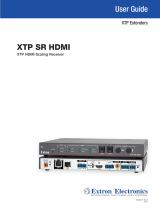 Extron electronics XTP SR HDMI User manual
Extron electronics XTP SR HDMI User manual
-
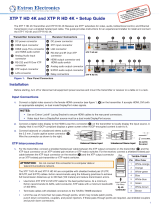 Extron electronics XTP R HD 4K User manual
Extron electronics XTP R HD 4K User manual
-
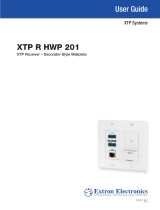 Extron electronics XTP R HWP 201 User manual
Extron electronics XTP R HWP 201 User manual
-
Extron electronics IN1808 Series User manual
-
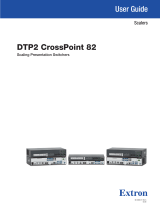 Extron electronics DTP2 CrossPoint 82 IPCP SA User manual
Extron electronics DTP2 CrossPoint 82 IPCP SA User manual
-
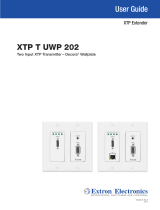 Extron electronics XTP T UWP 202 User manual
Extron electronics XTP T UWP 202 User manual
-
Extron electronics 1600 User manual
-
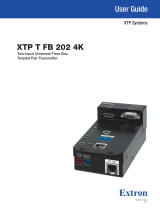 Extron electronics XTP T FB 202 4K User manual
Extron electronics XTP T FB 202 4K User manual
-
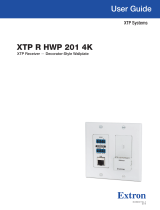 Extron electronics XTP R HWP 201 User manual
Extron electronics XTP R HWP 201 User manual
Other documents
-
Extron XTP R HD 4K User manual
-
Extron XTP T HDMI User manual
-
Extron XTP SR HDMI User manual
-
Extron XTP SR HD 4K User manual
-
Extron XTP FR HD 4K User manual
-
Extron XTP T USW 103 User manual
-
Extron XTP SFR HD 4K User manual
-
Extron XTP FT HD 4K User manual
-
Extron XTP T USW 103 4K User manual
-
Extron XTP CrossPoint 1600 User manual








